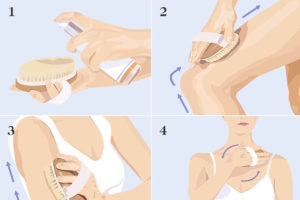The Truth About Dry Brushing
There are a variety of health claims about dry brushing. For those who aren’t familiar with the technique, it involves daily body massage with a dry, stiff-bristled brush. It’s been said to help flaky winter skin, increase circulation, detoxify, help digestion, and even improve the appearance of cellulite. But are these claims true? Here are some of the most pressing questions you might have about this technique, answered.
What Exactly Are the Benefits?
The action of dry brushing is incredible for exfoliating dry and scaly winter skin. It also helps detoxify by increasing blood circulation and promoting lymph flow/drainage. Dry brushing unclogs pores in the exfoliation process. It also stimulates your nervous system, which can make you feel invigorated afterward.
Does It Help Cellulite?
There’s no actual evidence of this claim, but most likely what people interpret as cellulite reduction is really just a temporary plumping up of the skin from increased blood circulation.
Why Not Do It In the Shower?
Brushing the skin while it is dry allows you to exfoliate and increase blood circulation without robbing it of moisture. Brushing your skin in the shower can lead to drier skin.
What Kind Of Brush Should I Use?
You want to use a natural stiff-bristled bath or shower brush, preferably with a long handle. Some bristles are stiffer than others, so it depends on your sensitivity and preference. The long handle helps you reach your back.
So How Do I Do It?

You always start on dry skin using a natural bristle brush. Start from the feet or ankles and work your way upward in long fluid strokes on limbs and circular motions on torso and back. Make sure to move in an upward direction. It can be sensitive on the abdomen and neck, so lighten up pressure as needed.
A long handle is helpful so that you can get to the back, which can be brushed in downward strokes. A few strokes per area is enough. If you go over one area too long, you can actually break the skin and cause irritation or bleeding. You generally do this once each day and shower immediately afterward.
When Should I Dry Brush?
The best time to dry brush is just before a shower. Then you can wash off any dead skin cells and flaky skin. Be sure to apply lotion afterward to put moisture back into your skin.
What About Sensitive Skin?
Never brush over skin that is broken, which includes cuts, scrapes, lesions, sores or burned skin (including sunburns). Don’t ever brush over areas of infection, redness or general irritation, inflammation, cellulitis or skin cancer. Stop dry brushing if skin becomes irritated or inflamed. Do not use the brush on your face, as this is too harsh for your facial skin. These brushes have bristles that are generally very firm. If your skin is too sensitive, you may want to switch and try a plain dry washcloth or exfoliating gloves.
Interested in a luxurious beauty treatment at Sculpt CosMedics? Call (718) 998-9898 to book a private, one-on-one appointment today for a facial, chemical peel or laser treatment!